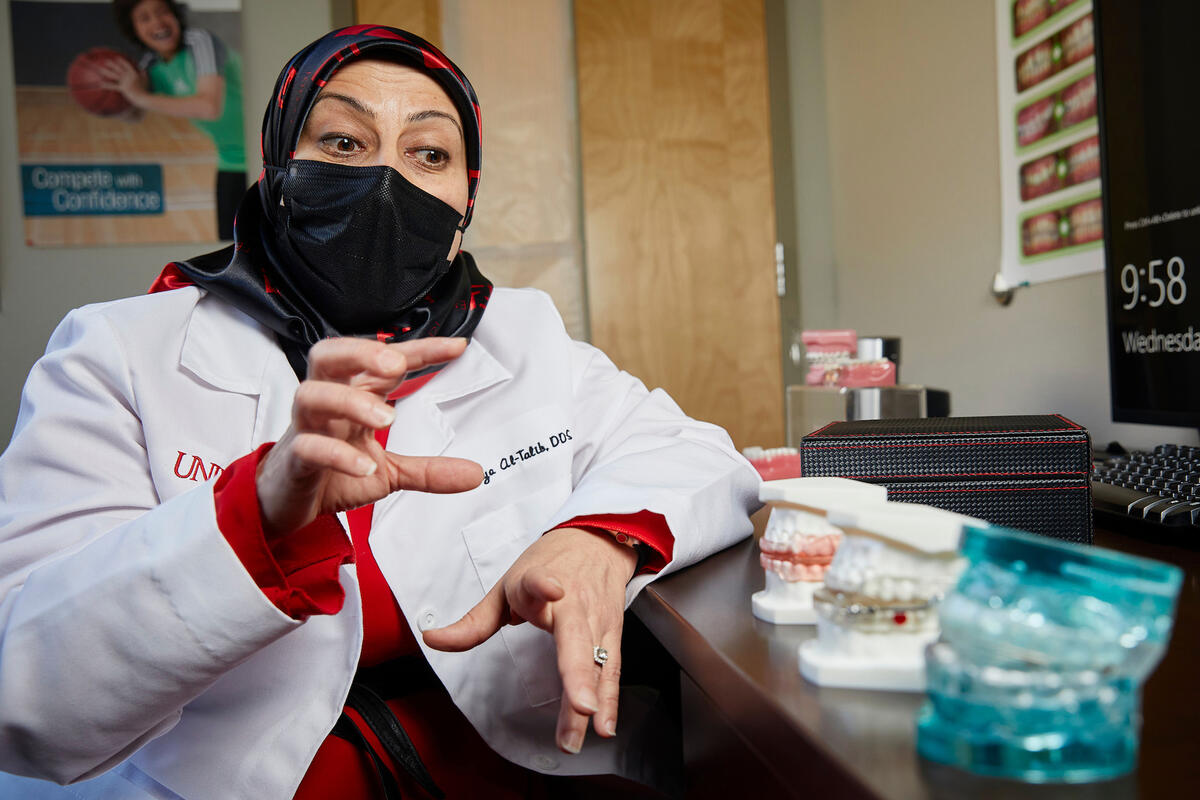What happens in your mouth might just end up affecting your whole body. That's what School of Dental Medicine orthodontist Dr. Tanya Al-Talib maintains. She encourages her dental students to treat patient visits as opportunities to catch other ailments in their earliest stages.
And there’s one ailment she’s passionate about detecting — breathing issues during sleep such as sleep apnea.
“People who snore usually know they do thanks to a bed partner, but those who may be susceptible to or who have sleep apnea may not,” said Dr. Al-Talib. “And unless a person expresses concern about his or her sleeping habits, a medical professional won’t automatically check for signs of the disorder. Since most comprehensive dental screenings check vitals, height and weight, and head and neck pathology, I saw an opportunity to look for potential indicators of sleep breathing issues.”
Al-Talib implemented questionnaires that, paired with anatomical criteria, evaluate the risk levels for sleep apnea and other sleep breathing issues among children and adults. Her efforts could become standard practice.
Triangulating on the problem
Al-Talib began her first sleep breathing issue research during her orthodontic residency program. Her inspiration arose close to home when a toddler in her family began to snore lightly and complain of slight headaches after a night’s rest. In that first study, she evaluated the non-nutritive sucking habits and feeding habits of pediatric patients, seeking a correlation to breathing problems during sleep. The initial findings uncovered a connection to feeding habits.
When she joined UNLV in 2015, Al-Talib wanted to expand the study within the adult population. She used the Epworth Sleepiness Scale to calculate a person’s excessive daytime sleepiness and used cone-beam computed tomography to determine his or her airway volume.
“Since we use [tomography] machines to identify different skeletal and dental issues for our orthodontic patients, I started using the completed scans to measure a person’s airway and determine its narrowest part,” Al-Talib said. “I also collected data on height, weight, neck circumference, alignment, and skeletal make-up, and then combined it with data from the Epworth survey, airway measurements, and jaw discrepancy. So far, we have found an interaction between daytime sleepiness and skeletal make-up.”
The school started using the questionnaires for adults during summer 2018 and has screened nearly 8,600 people with possible sleep breathing issues. Al-Talib evaluated those with high questionnaire scores and referred them accordingly to local sleep labs for evaluation. A pediatric version of the questionnaires has been implemented recently as well.
Sleep breathing problems and ADHD?
One of Al-Talib’s related research projects investigates the potential correlation between obstructed sleep apnea and traditional characteristics of attention deficit hyperactivity disorder among pediatric patients.
“When obstructed sleep apnea interrupts a child’s quality of sleep, he or she may be harder to wake in the morning, easily distracted, and become hyper and more agitated during the day,” Al-Talib said. “These symptoms can be seen in true ADHD patients, but the cause could also be obstructive sleep apnea or other sleep problems.”
Dentists and sleep apnea
Al-Talib said local dental offices should become more involved with treatment options for those with sleep apnea or other sleep breathing disorders, including snoring.
“The standard of care for sleep apnea patients is the continuous positive airway pressure mask. For those patients who have mild sleep apnea or don’t tolerate the CPAP, an oral appliance could be a successful treatment option provided it is prescribed by a sleep physician. The appliance, which is similar to a retainer, employs an advancing mechanism that moves the lower jaw forward and helps open the airway during sleep. The same appliance can also aid those who snore.”
Al-Talib will continue her research, exploring how dentists can further the quality of life and sleep among their patients
She also plans to present her findings to other health-focused organizations, dental schools, and dental/medical professionals. During 2019 and 2020, Al-Talib accepted invitations to speak or lead continuing education sessions and webinars about this topic at organizations such as University Medical Center in Las Vegas, the American Academy of Dental Sleep Medicine Meeting in Washington D.C., the Saudi Dental Education Society in Saudi Arabia, and the University of Mosul, College of Dentistry in Iraq.
So, if you snore, experience daytime sleepiness, or are concerned about yourself or someone else’s sleeping and sleep breathing habits, remember to speak with your primary care provider, and your dentist.



